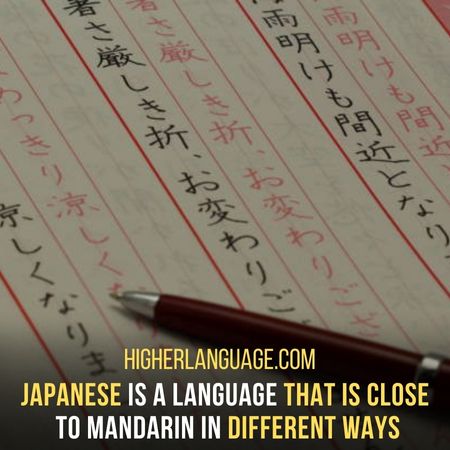If you’re looking for languages similar to mandarin, there are a few options worth considering. You can go for Shanghainese, Thai, Xiang, Vietnamese, etc.
[toc]
Furthermore, there is a huge list of available options for you. For example, some popular options are Hakka, Korean, Cantonese, Min Nan, and Japanese. Read more to go deeper!
Languages Similar To Mandarin – 9 Choices!
Mandarin is the language of 1.31 billion people around the world. It is the official language of China and Taiwan. It is also one of the six languages of the United Nations.
Chinese have multiple languages and dialects. The most commonly spoken are Mandarin, Wu, Yue, and Min.
It is difficult to learn, but there are several easy languages similar to Mandarin. So, they can help you a lot.
For instance, Sinitic branch languages of the Sino-Tibetan family are good for this. Like, Cantonese and Shanghainese are close to Mandarin.
Other languages in the same family include Vietnamese, Thai, and Hakka.
Some languages are distantly related to Mandarin but still share some similarities. These languages include Korean, Japanese, and Xiang.
All these languages share features with mandarin. Including the use of tones and Chinese characters, they are worth it.

If you’re looking to learn the languages similar to mandarin, these are a few good options to consider.
Following are some similarities between Mandarin and other related options.
1. Shanghainese:
Shanghainese is a dialect of Wu Chinese, which is a subgroup of Mandarin. Shanghainese is common in the Shanghai region of China.
It shares many features with Mandarin, including the use of tones.
The tone of a language means the use of pitch to distinguish meaning. For instance, the word ‘ma’ can mean either mother or horse, depending on the tone.
Shanghainese also uses the same written Chinese characters as Mandarin. For instance, the word for “hello” in Shanghainese is 你好 (nǐ hǎo), which is the same as in Mandarin.
Moreover, the writing style in Shanghainese is very similar to that of Mandarin. Like Mandarin, Shanghainese has a subject-verb-object word order in its sentences.
So, Shanghainese is mutually intelligible with Mandarin. That is, speakers of Shanghainese can generally understand Mandarin and vice versa.
2. Vietnamese:
Vietnamese is another language that is similar to Mandarin Chinese. As a result, the two languages share some common vocabulary and a similar tonal system.
For instance, the word for “hello” in Vietnamese is Xin chào (pronounced “sin chow”). This is cognate to the Mandarin word 你好 (pronounced “nee how”).
Additionally, both languages use tones to change the meaning of words.
Like, if anyone pronounces the word “ma” with a high-level tone, it means “mother”. However, in the case of rising tone, it means “horse” in Mandarin Chinese.
The same word in Vietnamese, “má” has the same two meanings depending on the tone.

Furthermore, Vietnamese also has a complex system of honorifics and kinship terms like Mandarin.
This means you must be careful about how you address people, depending on their age, social status, and relationship with you. So, both are quite the same.
3. Thai:
Thai is another language that is similar to Mandarin. For example, they both use tonal language. It means the same word can have different meanings depending on the tone.
Also, in Thai, people value honorifics and kinship terms, just like in Mandarin.
So you must address people depending on whether they are older or have a higher status than you.
For instance, if you are talking to your boss, you would use a different word than if you were talking to your friend.
And finally, like Mandarin, Thai has no grammatical gender. This means there are no masculine or feminine words – everything is neutral.
For example, the word for “person” is คน (khon), regardless of whether you are referring to a man or a woman in Thai. The same applies to Mandarin.
So, if you know Mandarin, learning one of these languages will be easier.
4. Korean:
Korean is another language that is similar to Mandarin in a few ways.
For one, Korean also has no grammatical gender. This makes it easier for speakers of Mandarin who are not used to masculine and feminine words.
Korean also does not have any articles (like “the” or “a” in English). This can make it seem simpler than languages with articles, like Mandarin.
Moreover, both use verb endings to show the speaker’s attitude or intention. For example, in Korean, the verb ending “-니다/-요” (-ni-da/-yo) shows respect to the listener.
In the same way, in Mandarin, the verb ending “吗/麽” (ma) makes a question sound more polite.
Finally, Korean has a subject-object-verb word order, which is the same as Mandarin. So, if you know Mandarin, you will be familiar with this word order in Korean.
5. Japanese:
Japanese is another language that is close to Mandarin in different ways.

First, both languages have no articles. So you don’t need to worry about whether a word is “the” or “a”.
Second, Japanese also has many homophones like Mandarin. This means that there are often multiple ways to say the same thing, and you can choose the one that sounds best.
Japanese and Mandarin also share some common grammatical structures. Like, both languages use particles to mark grammatical functions.
For example, in Japanese, the particle “wa” marks the topic of a sentence. While in Mandarin, the particle “de” marks the Possessive.
Moreover, both use verb endings to show the speaker’s attitude or intention. For example, the verb endings “masu” shows respect to the listener in Japanese.
In the same way, in Mandarin, the word “le” at the end of a sentence can show that the speaker has finished an action.
So if you know Mandarin, you will be familiar with this word order in Japanese.
6. Cantonese:
Cantonese and Mandarin are both languages of the Sino-Tibetan family.
They are similar in many ways. For instance, vocabulary-wise, around 70% of Cantonese words are cognate with Mandarin words.
For example, some common words for hello in Mandarin: 你好 (nǐ hǎo) and in Cantonese: 你好 (nei hou).
They are also similar in grammar. For example, both languages use topic-prominent word order. This means that the subject of the sentence usually comes before the predicate.
Another similarity is that both languages use tones to distinguish words.
So, for example, you can use pitch to change the meaning of a word in Mandarin, and you can do the same in Cantonese.
Finally, gender is not a grammatical category in either language. Thus, if you know one of these languages, learning the other will be a breeze!
7. Hakka:
Hakka is another language spoken in China that is similar to Mandarin. Just like Mandarin, Hakka is a tonal language, meaning pitch changes the meaning of words.
Some common points include the word order and the lack of grammatical gender.
For instance, there is no gender-specific pronoun for “he” or “she” in Hakka. Instead, the pronoun “ta1” refers to both males and females. The same goes for Mandarin.
Further, they do not have articles (a, an, the), and there are no verb tenses. So verbs always stay in the same form, no matter if they’re talking about past, present, or future tense.
In addition, both have a writing system that uses characters rather than an alphabet. Like, we don’t need the alphabet to write these languages.

Instead, we use logograms, which are single characters that represent a word or a phrase.
So if you’re looking to learn languages similar to Mandarin, Hakka is a good option.
8. Min Nan:
Min Nan is yet another Chinese language that is similar to Mandarin. It is common in southeastern China and Taiwan, and like Mandarin and Hakka, it is a tonal language.
Min Nan is also written with characters rather than an alphabet.
For instance, the character 來 (lái) can mean “come”, “future”, or “because”. Its meaning depends on the context in both languages.
Another common point between Min Nan and Mandarin is that both use measure words. In these languages, there are classifiers denoting the quantity of something.
For example, the character 個 (gè) is used as a measure word for people or objects.
So, someone might say, “I have two sisters” in Mandarin, using the character 個 (gè) as the measure word for “sisters”.
This is similar to how Min Nan speakers say, “I have two sisters,” using the character 個 (ko).
Min Nan and Mandarin also share some common grammar points. For example, both languages use the character 了 (le) to indicate completion.
“I finished eating” will be 了 (le) in these languages. Thus, we can say they are quite close.
9. Xiang:
Xiang is the Chinese language spoken in the Hunan Province of China. It is also a member of the Sino-Tibetan languages family.
Therefore, people find many similarities between Xiang and Mandarin. For example, the tones and grammar structures are quite alike.
In Mandarin, the character 很 (hěn) intensifies adjectives. Xiang speakers would use the same character 很 (hèn) for the same purpose.
In addition, words are usually created by combining two Chinese characters in Xiang, just like in Mandarin.
For instance, you can put the characters 行 (xíng) and 道 (dào) together to form the word “road” or 行道 (xíngdào) in Mandarin. The same goes for Xiang.
Moreover, the vocabulary between the two languages shares a lot of similarities. For example, the word for “book” is 书 (shū) in Mandarin and 書 (shū) in Xiang.
For example, the Mandarin word for “three” is 三 (sān), while the Xiang word is also 三 (sǎng). So, if you know how to count to ten in Mandarin, you’ll be able to do the same in Xiang.
Conclusion:
China is one of the most linguistically diverse countries in the world.
With over seven hundred languages in the country, it can be difficult to know which language to learn.
But if you’re looking for languages similar to Mandarin, you can easily find many options. Some languages like Shanghainese, Cantonese, and Hakka are similar to Mandarin.
Furthermore, some famous languages like Thai, Japanese and Korean are close too. Also, Min Nan and Xiang have some similarities.
So, if you want to learn languages similar to Mandarin, many options are available. Just choose one that interests you the most!